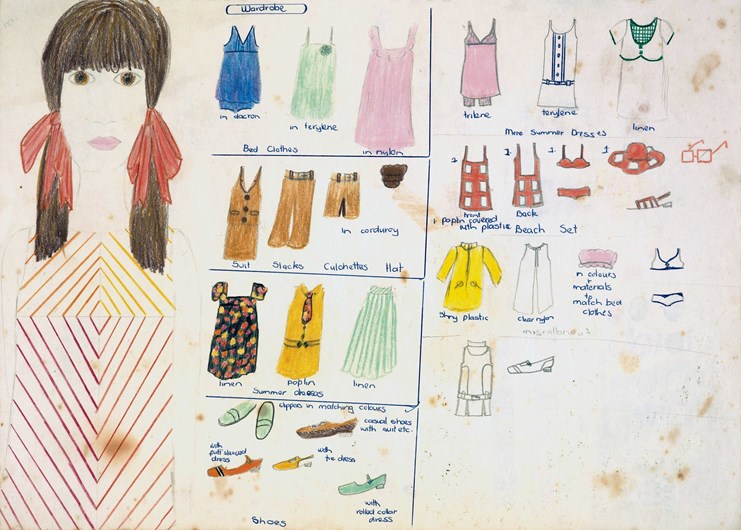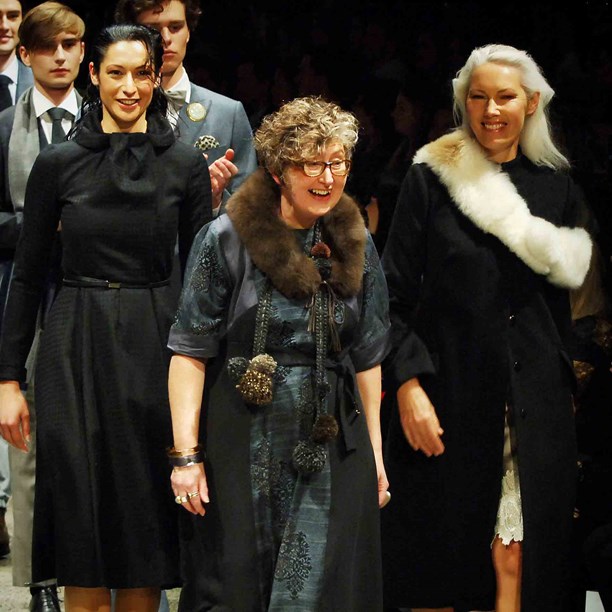Stories
Liz Mitchell
1990- (label)

"Mum found a piece of paper when I was about seven that said I wanted to be a fashion designer."
While Liz Mitchell can’t recall writing those words, she does have strong memories of poring over her mother’s L’Officiel magazines, which she has kept to this day. Within those pages she discovered designers like Chanel and Dior and began a lifelong love affair with the fashions of the 1950s. Combined with her later passion for theatre, this aesthetic has produced the unique combination of exquisite tailoring and theatricality that is the hallmark of a Liz Mitchell garment.
When Liz launched her own label from her Auckland home in 1990, she also launched a design career that has seen her garments worn on red carpets here and overseas. As Prime Minister, Helen Clark attended the international premiere of The Return of the King in 2003 wearing a slate-coloured Liz Mitchell gown with a chainmail wrap made by Weta Workshop. In turn Weta Workshop’s Sir Richard Taylor has worn Liz Mitchell at premieres and awards, and it was Liz who designed Keisha Castle-Hughes’ first 'grown up' gown for her Oscar night in 2002.
Among the many awards Liz has won over the years is the one she treasures most. In 2005 she was made a Member of the New Zealand Order of Merit (MNZM) for services to the New Zealand fashion industry. This acknowledgment set the seal on her status as one of this country’s few true couturiers.
Liz Mitchell grew up in the suburb of Glenfield on Auckland’s North Shore. The eldest of four children and the only girl, she was especially close to her mother, Aileen (who died in 2012), whom she describes as a very stylish and beautiful woman. Aileen, a trained draughtswoman, created and sewed clothing for herself and 'made to order' for her daughter. "I was much better at giving her instructions than sewing," Liz laughs. Both loved knitting.
Drawing was another joy. Liz’s childhood creation 'Branchy' was a slender girl bearing more than a passing resemblance to 1960s supermodel Twiggy. Detailed sketches of her outfits with specifications about fabric and accessories, printed in Liz’s childish hand, are now held in the Te Papa archives, along with costume designs and a selection of Liz Mitchell garments.

‘Branchy’ and her wardrobe, 1965. Image © Liz Mitchell.
From this background it would seem that Liz’s career path into fashion design was set early, but at Auckland Girls’ Grammar in the 1970s when feminism was in full swing, girls were encouraged into 'serious' careers. Liz was good at science and maths and strongly considered becoming a doctor.
But she was also being drawn into the vibrant world of Auckland theatre. Her good friend Kate was the daughter of Mercury theatre director, Tony Richardson. Kate and Liz ushered at the Mercury and Liz often stayed over in the city for theatre parties where they met actors, directors and playwrights. "I realised there was another side of me that needed to do something with art. The combination of literature and art attracted me. I ruled out fashion though – I didn’t think it was that important."
Liz enrolled at the Elam School of Fine Arts, graduating in 1979, while also working part-time at Theatre Corporate. Fashion wasn’t entirely left behind. As a student she’d made items for emerging boutiques, including punk designer Miranda Joel’s Pussyfooting. She also did costume design for David Blyth’s 1979 punk film, Angel Mine, and costumes for Mary-Jane O’Reilly’s fledgling Limbs Dance Company.
In 1981, Liz got an Arts Council grant to study at the Australian Opera Company. Two years later she headed to London on a British Council Grant to work with designer Russell Craig, whom she’d met in Auckland. They worked on productions for the English National Opera, the Scottish Opera and Opera North, before she returned to a design job at the Mercury.
Her UK experience had taught Liz that Kiwi designers had much wider opportunities than their British counterparts. She applied for a job as a costume designer with Television New Zealand in 1984 thinking it would lead to set designing. Instead it was to open the doors to her future career in the fashion industry.
The first TVNZ assignments on the Steel Riders and Seekers series were with producer Janice Finn, who was busy developing a local soap opera. Set in the offices of a fashion magazine controlled by the wealthy Redfern dynasty, Gloss premiered in 1987. Its over-the-top fashions quickly became even more compelling for viewers than the scandalous storylines. As well as creating new garments each week, the design team led by Liz and Enid Eriksson, borrowed from local fashion houses such as Zambesi, Marilyn Sainty and Trelise Cooper. No one minded the exposure, and Liz developed networks within the fashion industry.

Costume design sketch for Gloss character Maxine Redfern (played by Ilona Rodgers), 1988.
Her confidence grew when cast members asked her to design for their personal wardrobes and her profile boosted even further by a contract to design gowns for the Lotto presenter. In 1989 hand knits were in style and, ever resourceful, Liz launched a handmade knitwear range wholesaled through the Keith Matheson and Arthur Barnett stores.
Having worked behind the scenes on the Benson & Hedges Fashion Design Awards, Liz decided to enter and won the ‘Lifestyle’ section award in 1990, the year she officially launched her label. By then Gloss had finished and everything pointed towards a full-time fashion career.
She’d won a second Benson & Hedges award in 1992 and, freelancing from her home workroom, she now employed staff. Sample machinist Carmel Hoskyn – trained at Babs Radon – joined the workroom and still works with Liz. Her first pattern maker, Lewis Townsend, who had worked for El Jay, was followed by John Kite, ex-Colin Cole and Kevin Berkahn.
In 1994 she found the ideal premises to establish the first Liz Mitchell atelier. "I saw that Peter Webb’s auction rooms in Elliott Street were empty. It was a beautiful space and I remember thinking that I’d hate to get to another point in my life and realise that I should have set myself up as a fashion designer. We did a ready-to-wear range each season plus a lot of bridal and school ball dresses. Being in the city, professional women around town could pop in. It was exciting, quite grand even!" As if to set the seal on her decision, the atelier won the Wools of New Zealand interior design award in 1995.
Because she’d never formally worked in the fashion industry, Liz didn’t have a bible of how things should be done. "When I started fashion designing it was about sketching, creating a toile, creating a pattern. With theatre and TV you design for a character, working one-on-one. This was similar, particularly with bridal work. It’s the moment in someone’s life when they’re going to be on stage and the relationship you build with them is really special."
Fabric, colour and texture have always inspired Liz. She travelled to international textile fairs such as Premier Vision, to buy fabric. These days fabrics are sourced through the internet.
Liz has shown at several New Zealand Fashion Weeks and in Australia. She was guest designer at the iD Fashion Week in Dunedin in 2011. She loves the excitement and ‘pure theatre’ of putting a collection on stage.

Liz Mitchell with models at New Zealand Fashion Week 2015.
Her Kiss of the Dragon New Zealand Fashion Week 2003 collection was inspired by In the Mood for Love, a film set in 1950s Hong Kong. 'Night Flowers of the Pacific' (2005) came from her observations of the Pacific artifacts at the Auckland War Memorial Museum. That year visiting Los Angeles stylist Cameron Silver described Liz Mitchell as 'the Chanel of New Zealand'.
Keen to diversify her business, in 2006 Liz branched out of ‘high end’ designing to do a diffusion range for the Farmers’ stores. ‘Mitchell by Liz Mitchell’ was followed by a lingerie line, ‘Tailored by Liz Mitchell’. Both lines continued for some years and taught her much about the global fashion industry and manufacturing in China.
Liz put her company into voluntary liquidation in 2010. Having survived breast cancer earlier in the decade, she was able to survive this business setback by rebuilding her brand as a leaner entity. Adversity has given her inner strength and renewed creativity. It has also taken her back to her core strengths.
Liz’s focus is on bespoke tailoring, working with exclusive fabrics, selling directly to local and international clients. Her skilled team is unique today in providing a personal service with exquisite tailoring and couture with an attention to detail. She also relates to women of the baby boomer generation’s desire to keep contemporary and stylish.
Her Grey Lynn showroom exudes the aura of theatrical glamour that is the Liz Mitchell ‘trademark’ with a new emphasis on sustainability. Liz is an Ambassador for the Campaign for Wool, an international response to reduced awareness of the benefits of the natural properties of wool. Garments from her 2015 Choose Wool New Zealand Fashion Week collection are suspended from brass hangers crafted for her original Elliott Street showroom. Alongside hang jackets re-worked from Japanese kimonos and woollen coats with hand-stitched finishing.
New opportunities are developing with the local Chinese business community for exporting luxury accessories with New Zealand craftmanship into China’s domestic market.
Reflecting on some of her earlier designs she acknowledges that they’re now a little less theatrical. "I’m more interested in an understated aesthetic. It’s about the beauty of the material, the beauty of the cut, exquisite workmanship and the idea that 'less is more'."
Text by Katherine Findlay. Banner image of Liz at the ANZMAC conference dinner.
Last published November 2015.